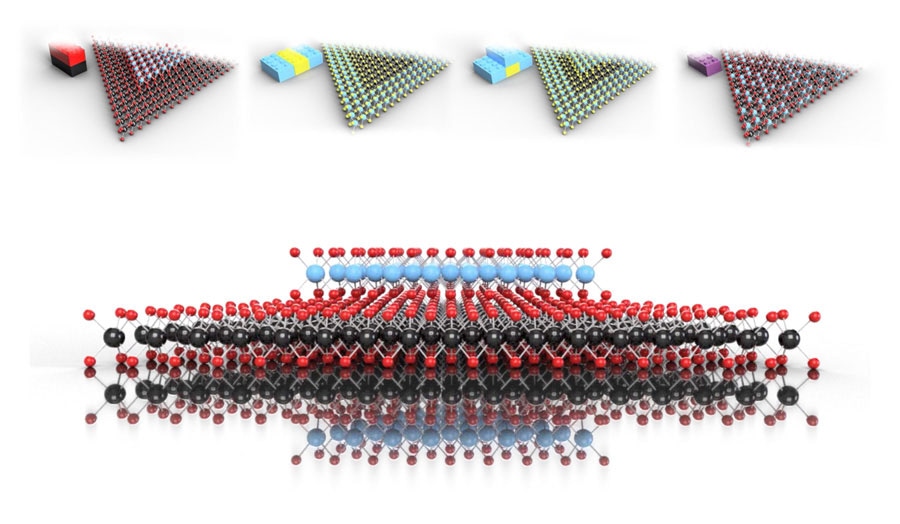May 31 2018
Northwestern University researchers have developed a unique blueprint design to construct new heterostructures using different types of 2D materials.
 Top: Vertical MoSe2-WSe2 heterostructure, radial MoS2-WS2 heterostructure, hybrid MoS2-WS2 heterostructure and Mose2-WSe2 alloy building block representations and crystal structure models Bottom: Vertical MoSe2-WSe2 heterostructure crystal structure model (Credit: Cain, Hanson and Dravid)
Top: Vertical MoSe2-WSe2 heterostructure, radial MoS2-WS2 heterostructure, hybrid MoS2-WS2 heterostructure and Mose2-WSe2 alloy building block representations and crystal structure models Bottom: Vertical MoSe2-WSe2 heterostructure crystal structure model (Credit: Cain, Hanson and Dravid)
Being single atom layers, 2D materials can be stacked together just like “nano-interlocking building blocks.” The properties of 2D materials and their promising applications have attracted the interests of physicists and materials scientists, alike. The unique blueprint design has been described in the Journal of Applied Physics, from AIP Publishing.
“We’ve outlined an easy, deterministic and readily deployable way to stack and stitch these individual layers into orders not seen in nature,” said Jeffrey Cain, the paper’s author who was formerly at Northwestern University and is now at the University of California and Lawrence Berkeley National Laboratory.
Cain elaborated that nanoscientists always dream to integrate 2D materials in any order and compile a collection or library of these heterostructures with their documented characteristics. This will allow researchers to choose the most suitable heterostructures from this library for their required applications. For example, the computer industry is attempting to develop smaller and faster transistors in order to boost the computing power. A nanoscale semiconductor with desired electronic properties can be possibly used for making transistors in futuristic computers.
Until now, clear techniques were not available to nanoscientists to fabricate heterostructures, and as a result they were not able to develop this library yet. In this analysis, the researchers explored other options to overcome these fabrication problems. Once the researchers identified trends in the literature, they tested various conditions to map out the various parameters needed to grow particular heterostructures from four different types of 2D materials such as tungsten disulfide and diselenide, and molybdenum disulfide and diselenide. In order to completely define the atomically thin end products, the team employed microscopy and spectrometry methods.
The researchers were motivated by the science of time-temperature-transformation diagrams in traditional materials, which create accurate metallic microstructures by mapping out heating and cooling profiles. On the basis of this technique, the scientists packaged their findings into a single diagrammatic method called the Time-Temperature-Architecture Diagram.
People had previously written papers for specific morphologies, but we have unified it all and enabled the generation of these morphologies with one technique.
Jeffrey Cain
These unified Time-Temperature-Architecture Diagrams offer directions for the precise conditions needed to create many heterostructure compositions and morphologies.The researchers used these diagrams to come up with an exclusive library of nanostructures that have the physical properties of interest to materials scientists and physicists. The researchers at Northwestern University are now studying the behaviors exhibited by certain materials in their library, for example, the flow of electrons across the joined junctions between materials.
The scientists hope that their new blueprint design will prove handy for fabricating heterostructures beyond the first four materials.
Our specific diagrams would need revisions in the context of each new material, but we think that this idea is applicable and extendable to other material systems.
Jeffrey Cain